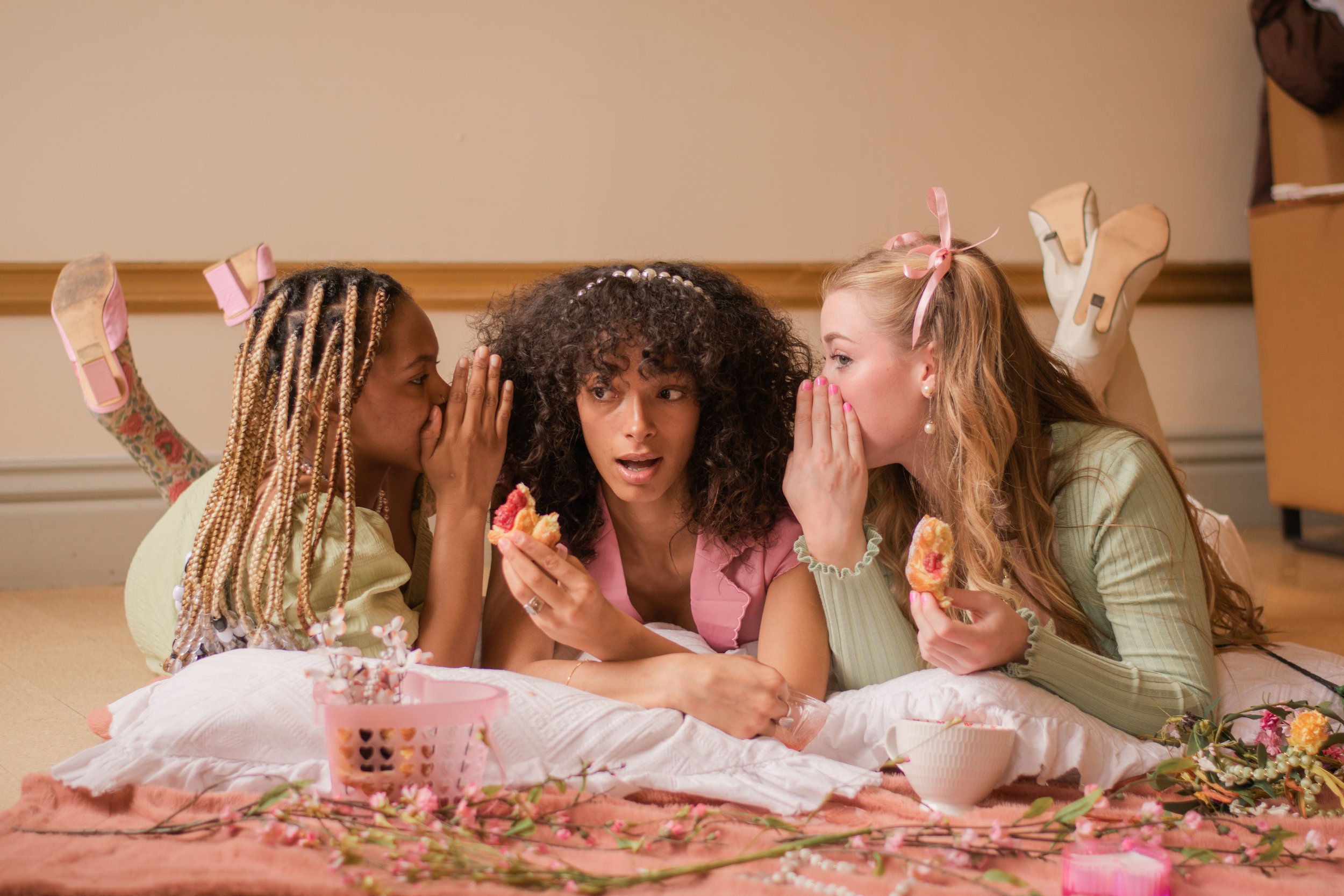Coquette Reimagined
Reclaiming and celebrating hyper-femininity
Written by Erin Galioto, Fashion Team Staff
Photographed by Tara Osbourne, Contributing Photographer
Modeled by Ella Gale, Kamyia Denson and Jekiah Manor
Following the introduction of TikTok, there has been a swift increase in exposure of niche microtrends formerly hidden in the depths of Tumblr threads and Pinterest boards. The latest resurgence? “Coquette.”
Inspired by aesthetics like princess-core, messy French girl and 2014 soft pale grunge, the coquette aesthetic is characterized by baby-doll dresses, frills and lace, dainty floral print and Mary-Jane heels (Roby, 2022). With spring just around the corner and the release of Bridgerton season 2, the romantic style and calm beauty of the coquette aesthetic are rapidly growing in popularity.
However, the origins of this trend are much darker than the pastel-colored dream that appears on the surface. The style is visually similar and often mistaken as the “nymphet” aesthetic, which has a problematic past. Historically, Greco-Latin mythology featured “nymph” deities that lived for external pleasure and judgment from other powerful men (Lores, 2022). In Vladimir Nabokov’s Lolita, main character Humbert Humbert used the term “nymphet” to justify his obsession and predatory actions toward the underage Dolores Haze. Movie adaptations of the 1955 novel feature Dolores in milkmaid braids tied with ribbons, retro swimsuits and ruffled blouses. Her style was adopted by Tumblr users and dubbed under the same problematic term used by Humbert. The aesthetic later came under scrutiny and criticism for glorifying pedophilia and romanticizing relationships where inequality and the male gaze play a key role (Fandom, 2020). The style is still vilified today for catering to outdated female beauty standards and reducing women to objects of lust and adoration.
Although the pieces and composition of coquette fashion mirror that of nymphet, the story behind it is much different. The reinvention represents embracing one's femininity instead of hyper-sexualizing innocence. It is not shameful to be amused by soft and “girly” pastimes and clothing. Today’s coquette is an act of subverting gender and underlining femininity. Coquette influencer Andrea Herrera del Valle (@peanutmochi) calls it “an act of surrender and pure indulgence” in femininity in which the male gaze does not exist (Lores, 2020).
My own act of feminine indulgence takes place in the privacy of my bathroom where I take my time methodically applying each of the overpriced, ornamentally packaged skincare products on my vanity. This type of ritualistic indulgence in femininity is an act of self-infatuation and for no one’s pleasure but your own. It is sending love letters to yourself on a daily basis.
Recently, much-needed attention and awareness are being shined on mental health. Within this conversation is the exercise of honoring your inner child. Adult life is filled with structure, rigidity and corporate attitudes that can reduce us to robotic routines. Our minds, once blooming with imagination and fantasy, are now reprogrammed to focus on productivity and logic.
Embracing whimsy and playfulness helps reconnect us to our core, juvenile selves and brings our lives the magic and sensitivity they crave. The coquette aesthetic is the embodiment of this idea, allowing us to indulge in escapism and nostalgia. It is a space for tea parties, bouncing in harmony with our tulle dress and appreciating the fragility of the tiny bow on the collar of our blouse.
For those looking to introduce more idyllic youthfulness into their wardrobe, there are several pop culture moments and moguls to look to. The directorial style of Sofia Coppola is a perfect embodiment of coquette themes. In her film “The Virgin Suicides,” she captures the nuances of feminity and the intricacies of girlhood using soft grading and pastel tints. The scenes in “Marie Antoinette'' are abounding with frills, bows, garters and lace (Roby, 2022).
Self-proclaimed as a muse for those who embrace “their authentic, delicate selves” Lana del Rey’s style and music are another incarnation of coquette. Her 2012 album “Born to Die” represents vintage Americana and is heavily inspired by aesthetics of the ‘50s and ‘60s (Fandom, 2020). Lily Rose Depp, Taylor Swift and Olivia Rodrigo are among other celebrities to look to for fashion inspiration as well as influencers like Duckie (@whoisduckie) on TikTok or Isabella Ricci (@isa.bella.ricci) on Instagram.
Here are some coquette essentials to search for:
Lace camisoles
Silk or satin skirts
Tulle dresses
Pointelle knits
Dainty floral prints
Sundresses
Frilled, lace undergarments
Babydoll tops or dresses
Gold, heart-shaped jewelry
Ribbon details
Mary Jane heels
Knitted stockings
Pearls
Socks with ruffles
Embroidery
Mini skirts
Oxfords
Remember, coquette is more than just sundresses and bows in your hair. It is a lifestyle of indulging in simple pleasures, embracing your natural beauty and flirting with your divine feminity. Complete your coquette look by opening the windows in your apartment while baking heart-shaped cookies, browsing your local antique shop, and brooding over a copy of “My Year of Rest and Relaxation.”
Sources:
Fandom. (2020, February 20). Nymphet. Aesthetics Wiki.
Lores, A. (2022, March 21). Coquette Aesthetic: the trend that is sweeping TikTok and that mixes evasion, historicism and fake femininity. Vogue España.
Roby, I. (2022, February 10). Coquette is the new romantic aesthetic that's all over TikTok. Nylon.
Sinay, D. (2022, March 25). "Princesscore" Makeup Is A Bridgerton Lovers' Dream Beauty Trend. Bustle.



